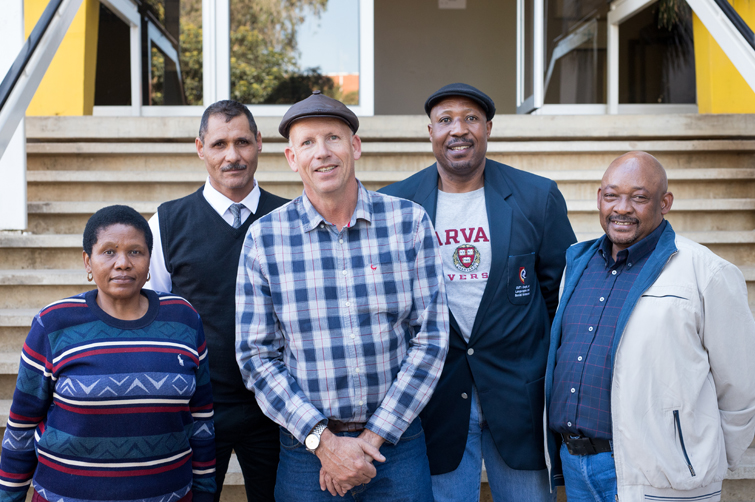Latest News Archive
Please select Category, Year, and then Month to display items
13 January 2020
|
Story Eugene Seegers
|
Photo Anja Aucamp
 Spearheading the digital expansion of the conversational Sesotho course is IDEAS Lab Director, Johann Möller (middle). With him are from the left: Prof Pule Phindane, CUT; Dr Brenton Fredericks, CUT; Bahedile Letlala, UFS Department of African Languages; and Dr Elias Malete, UFS Department of African Languages.
Spearheading the digital expansion of the conversational Sesotho course is IDEAS Lab Director, Johann Möller (middle). With him are from the left: Prof Pule Phindane, CUT; Dr Brenton Fredericks, CUT; Bahedile Letlala, UFS Department of African Languages; and Dr Elias Malete, UFS Department of African Languages.
For many years now, the UFS has been offering a one-year course in conversational Sesotho for staff members; this can then be followed up with the one-year course in advanced conversational Sesotho. The conversational Sesotho for students in the Faculty of Education was introduced in 2018 at the UFS.
The Central University of Technology (CUT) needed a conversational course for its first-year students and approached the Department of African Languages for the development of such a course. Living as we do in a multilingual country; this additional language skill opens doors and often hearts as well.
Using instructional design principles
However, the need was identified by both CUT and UFS to present this crucial information in a way that would be more appealing to digital natives as well as to those less familiar with technology. The Department of African Languages on the UFS Bloemfontein Campus, together with relevant departments from the CUT, approached the IDEAS Lab located on the UFS South Campus, since they already have a reputation for being a specialist on broadcasting and repackaging curricular content for digital presentations. The IDEAS Lab provided technical advice and built the multimedia programme, which will help the user to hear and practice phrases in Sesotho, using instructional design principles. The course will be available to both staff and students belonging to the two universities.
Room for growth
Johann Möller, Director of the IDEAS Lab, says this pilot programme will give both institutions the opportunity to test the use of multimedia for language acquisition. He adds, “Language is extremely complex, and we would like to expand this learning aid in the future.” In fact, the original design has room for growth built into it.
To keep things simple for the user and the building team, it was decided to start out with only four potential everyday scenarios where a staff member would like to speak Sesotho: Firstly, how to greet other persons from different genders; secondly, potential scenarios one might encounter in the university environment itself; thirdly, how to deal with situations at a hospital; and finally, how to use one’s language skills at a filling station.
Pronunciation is key
Each scenario contains three to four conversations that the learner can revise, along with images and audio that illustrate the situation and assist with correct pronunciation. The system does not allow the user to progress unless they have listened to the pronunciations of the sample sentences or phrases.
Further reading material and vocabulary lists are also provided, with the result that people who are using the programme can learn at their own pace. The authoring software Articulate Storyline was used to build the individual scenarios and each conversation or lesson within it. The lessons are also not dependent on an internet connection; they can be downloaded onto a flash memory drive and used offline.
Department of Architecture builds next generation of architects
2010-03-22
 |
| With Prof. Jonathan Jansen, Rector and Vice-Chancellor of the UFS are René Malan en Sancha Olivier. |
Since 1987 first-year architecture students have been building huts on campus annually as part of an introduction to architectural studies at the Department of Architecture at the University of the Free State (UFS).
According to Martie Bitzer, Senior Lecturer in the Department of Architecture, the students build these full-scale huts in groups of two, with responses to orientation, materials (grass, reads, earth construction – mud bricks), climate and community over a period of approximately three weeks.
On the day that the students completed their huts, Prof. Jonathan Jansen, Rector and Vice-Chancellor of the UFS, visited the small community of 27 huts in the veld behind the Rag Farm. Here he was taken on a walk amongst the huts. He also addressed staff and students of the Department of Architecture
“I can smell excellence and goodness,” was some of Prof. Jansen’s remarks as he walked amongst the huts.
“Top students come to our Department of Architecture. Quality attracts quality. The recent achievements of this department are proof of this,” he said.
One of Kovsies final-year students, Wim Steenkamp, was named National Corobrik Architecture Student of the Year 2008. This was the second time in the past three years that a student from the UFS Department of Architecture has won this prestigious competition. The department also received unconditional accreditation from the South African Council for the Architecture Profession (SACAP) for all three courses offered, and over the past few years its students have won the Tripod Photography Competition, the National Cement and Concrete Institute Competition for honours students, and the Carl and Emily Fuchs Foundation Student Prestigious Prize.
This once again confirms the prestige the department enjoys in the field of architecture in South Africa. It is also proof of the quality of staff and the programmes offered at the department.